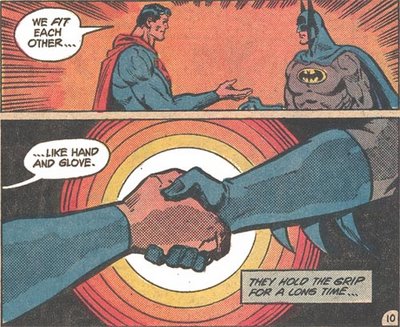
NOTE: THIS WAS ORIGINALLY POSTED IN DECEMBER 2014 ON AN OLD SITE. IT IS REPRINTED HERE, without revision, BECAUSE THIS INFORMATION WAS DEEMED TO BE IN THE NATIONAL INTEREST.
So this year, I’ve done my own little awards show. I’ve told you about the best debuts/#1s of the year. I spent a little time on horror comics, which underwent a mini-renaissance this year. And of course we talked about movie and TV adaptations.
Now it’s time for the big one, the main list, the books that I loved this most this year.
The problem with a list like this is usually not with what’s on it, but what’s not on it. And several omissions may be glaring. East of West isn’t here because somewhere along the line the book seemed to fall in love with itself too much, and as a reader I felt I wasn’t getting enough for my four bucks each month. Sex Criminals, which was my second favorite book of 2013, isn’t here because it clearly loved itself too much, taking an interesting premise and, somewhere around the sixth issue, devolving into Matt Fraction’s personal sex fantasies. Using writing as personal therapy is fine, but not everybody wants to read that.
Also, I read a crapton of comics. Now for the countdown….
30. Bitch Planet #1 (Image).

I was not expecting to like this comic. I am not a rabid Kelley Sue DeConnick fan–there are many of them out there. But this debut had depth and weight, masked as a simple prison exploitation comic. This is the kind of thing that can turn casual lefties into full-blown feminists–it’s a political book on one level, and on the other it’s a raunchy, violent remake of Sugar Hill: Escape From Women’s Prison.
I am almost certain this book would place higher on the list but there’s only been one issue as of this writing, so this is as high as it goes. For now.
29. Rasputin (Image).

I’d never heard of writer Alex Grecian or artist Riley Rossmo before, but they won me over with this odd, supernatural take on a Russian legend. The first issue was largely wordless, but managed to convey so many things with just a movement or story beat. And the art was tremendous. A great launch for what appears to be a highly experimental book.
28. Hip Hop Family Tree (Fantagraphics)

It’s a freakin’ encyclopedia of awesome, if you’re a hip hop nerd.
Last Year: This is a new book, so it didn’t make the 2013 list.
27. Beautiful Darkness (Drawn and Quarterly).

Fabien Vehlmann and Kerascoët created a magical book that on the surface looks like its for children, but the themes are terrifying. Yes, there are fairies, but they pop out of a dead girl’s body into a dying world. It’s like a fairy tale, but it’s designed for the kids of today who are older and much more savvy and cynical. Also, it’s oversized and absolutely beautiful to look at. Last Year: This is a one shot, so it didn’t place on my 2013 “best of” list.
26. Genesis (Image)
There were two great comics about the afterlife this year. One appears later on this list, and the other was this one. Genesis was a one-shot by Nathan Edmondson and Alison Sampson, with Jason Wordie doing some of the best coloring I saw this year, about a guy who dies and is reborn with infinite power—the power of God, essentially—and becomes so consumed with it that he forgets what gave his life meaning in the first place.
25. Secret Avengers (Marvel).


Lots of people loved this book from the start, but for me it was a grower not a show-er. It took me time to warm up to Michael Walsh’s rather unique artistic style, for one thing. But for another, there are so many tepid Avengers books out there right now that I wasn’t going to easily embrace this one. But I was warmed over by the scenes and the wild, out-there ideas. MODOK on a beach blanket
looking at the sun go down. A pregnant Terminator 2 style robot. A sentient bomb that wants to taste Carmel gelato. The hits keep coming. Last Year: The 2013 Secret Avengers were…Not good.
24. The Massive (Dark Horse).
Bryan Wood’s post-apocalyptic tale is heading for a big finale. It was still a damn good comic this year—with the highlight being an issue about a shoot out in a desolate wasteland—but the “mystic” nature of how it is all wrapping up doesn’t fit with the rest of the book, which was generally a neorealistic tale of environmentalists in a natural disaster, not a supernatural one. Last Year: Did not rank in top 20, but deserved an honorable mention.
23. Outcast (Image).

When I heard Robert “The Walking Dead” Kirkman was launching a new series about exorcism, I thought I’d pass. I’m not interested in the topic, and other than Walking Dead I’m not all that interested in the writer. Then I found out Paul Azaceta would be doing the art so I gave it a try. I’m glad I did. Rather than focus on little girls masturbating with crucifixes, Outcast is about a man who seems to be able to cast out demons, but he can’t escape being haunted by his own past. The book has remarkable complexity, and the narrative moves along at an appropriate pace: Creepy, but not creeping. Last Year: N/A
22. The Names (Vertigo).
Peter Milligan and the great Leandro Fernadez are crushing this new series, which seems to be part action movie, part spy novel, and part conspiracy theory. It starts out with a shady death, and then quickly moves to the widow, Katya, who is one of the only strong African American female leads in any comic on the stands today. In fact, she may be the only one. But don’t buy it to support diversity, buy it because it’s excellent. Last Year: N/A
21. Multiversity (DC).

A “haunted comic” is the key to the multiverses coming together in a sort of Secret Wars(ish) tribute to the many different types of comics DC has produced since the dawn of the superhero. Multiversity is fun—it’s a typical Morrison historical orgy, reviving offbeat characters like Captain Carrot and creating new and fascinating ones. I had high expectations for this book, and while it hasn’t lived up to the nearly 10 years of hype it got prior to publication, it’s still a damn fine superhero comic. There’s a lot there that could be the source of imaginative comics for years to come (but it won’t be—DC has never been able to mine the ore of Morrison’s worlds). And this will be one of Morrison’s final projects for the big two, so smoke it while you got it. Last Year: N/A
20. Andre the Giant: Life and Legend (First Second).
Comic book biographies are hard to do, and I’m not a wrestling fan, so Box Brown’s well-researched story about one of wrestling’s biggest (ahem) legends had to be great to get me to consider it for an end-of-the-year entry. And it was. Last year: N/A (one-shot)
19. Hawkeye (Marvel).
Constant creativity, constant surprises, and a cavalier “this doesn’t matter so I can do whatever I want” attitude infuse Hawkeye with a freshness and charm you don’t usually see in comic books. Great stuff, sad to see it end.
Last Year: #6
18. Batman (DC).
Whether pre- or post-New 52, Scott Snyder’s Batman has been a solid, reliable book—but one I often forget reading. This year, though, Snyder swung for the fences and knocked it out of the park. (Get it—a baseball reference for “Bat” man?) Zero Year was terrific, and Batman #36 (the one where he fought Batman) was the single best non-Grant Morrison Batman comic I’ve read in ten years. And it doesn’t hurt to have an artist like Greg Capullo design a Joker for the 2010s that is truly horrifying.
Last Year: Did not make top 20.
17. Daredevil (Marvel).
The bloom came off the rose for me this year in Daredevil, but only a little. I’ve loved Mark Waid’s work with the character, but after he moved to San Francisco I suddenly found myself liking him less. I’m not sure why. I love SF. Yet when he pulled out the “Children of the Purple Man” story in October, I remembered everything I loved about the book. So it lost its way a little in 2014, and shot down in my rankings (Waid’s DD has been in my top five for the past two years), but it ended strong. Waid and artist Chris Samnee are leaving the title next year—I can’t wait to see how they wrap it all up. Last Year: #3.
Hit “next” to continue!
16. Mind MGMT (Dark Horse).
I’ve loved this book from the beginning, but this year it started to wear a little thin for me. But only a little. It’s still fascinating, it still takes me a full half-hour to read every issue (compared with the more typical 10 minutes it takes for most books), and it’s still one of the most innovative story concepts around. Last Year: #4.
15. Superior Foes of Spider-Man (Marvel).

This book is light in the extreme. C-level characters fighting B-level villains where the stakes are usually just some loot. But who doesn’t love a good heist story? There are really two reasons why this book is great. First, it’s funny. Very funny. Sometimes tragically, painfully funny. I mean, the image of Silvermane being a severed head, totally dependent on others for movement, care, and feeding, and yet still being a complete nasty asshole is fantastic. In that way, he reminds me of Eric The Actor from Howard Stern. The second reason I loved this title (it’s been cancelled) is because it all feels so real. The art takes risks, the storyline is ridiculous, but everyone in it acts so naturally you could swear you know them personally. A great example of how comics can be fun and meaningless and yet still resonate as works of art. Last Year: 15.
14. Rachel Rising (Abstract Studios).
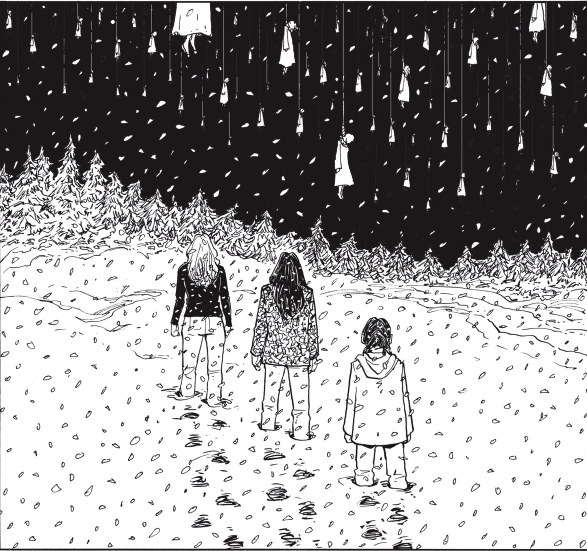
I’ve insisted over and over that Terry Moore is a genius worthy of all the awards, and this book about witches doesn’t prove me wrong. Beautifully illustrated and genuinely frightening, this is one book that I buy in both loose issue and bound form, so I can share it with anyone who will read it. Last Year: #14.
13. The Life After (Oni Press).
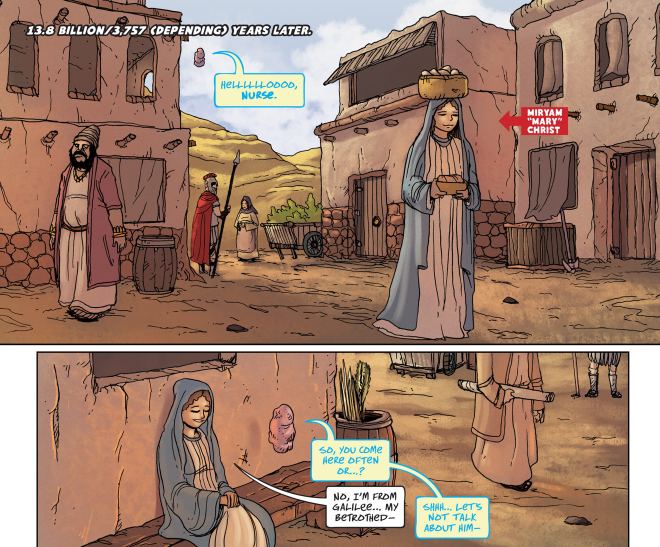
I’ve always liked Joshua Hale Fialkov’s writing. It’s not always brilliant, but one thing he can do is take a strange or tired premise and make it work. Whether it was his Harvey-winning scripts for Elk’s Run and Echoes, his Eisner-winning original graphic novel, “The Tumor,” or his work on “I, Vampire” for DC or his current webcomic, “The Bunker,” I always take the time to check his stuff out. And “The Life After,” with terrific and offbeat art by Gabo, is his best project yet. It’s about…Well, I’m not sure. The main character is in purgatory for trying to kill himself, so it might be about his arc. But it’s also about the nature of judgment and Hell. It’s got intrigue and conspiracy, Ernest Hemmingway, a creepy dog, and lots of chilling, extremely dark humor. I love this book. Incidentally, between this comic, the afore-mentioned “The Bunker,” and his newest book Punks, 2014 really has been the year of Fialkov. He even got Marvel money (for Ultimate FF), but I have to say that that project really didn’t work for me. Last Year: N/A
12. Lazarus (Image).

Greg Rucka and Michael Lark launched this gritty and grim vision of the future last year, but this year we saw it develop into a complex tapestry about family, honor, slavery, and classism. Social justice and social engineering are mainstays for comic books: They’re touched on in everything from the maniacs who want to take over worlds and cities and force them into their own image to the dystopia of most sci fi comics. But Lazarus isn’t really about that. I mean, it assumes a future in which the rich control everything and the poor must become terrorists just to get enough to eat, but that’s not what it’s about. It’s really about the children of this world—the kids who have to enforce society’s unjust rules, and who have become killing machines and warrior slaves in the service of the aristocracy. Also, the art kicks ass. Last Year: 10.
11. She-Hulk (Marvel).
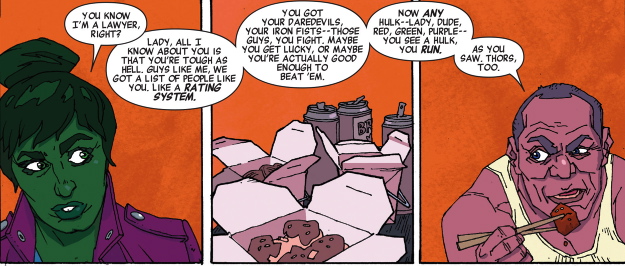
When this book started, I wasn’t sold. Now, it’s the first book I reach for when the new comics come out. In the “all-new Marvel” there are a plethora of corporate characters in titles that read like creator-owned indies: Black Widow, Rocket Raccoon, Hawkeye (the father of them all). What makes this one different is that Charles Soule knows how to make fun smart. She-Hulk is never silly, and there’s no meaningless events or banter. Every panel matters, every word counts. The fun comes from Jennifer Walters’ personal journey, and the unique way she looks at the world through green-colored glasses. In this book, we get a strong and different personality—there’s nothing cookie cutter here, and it’s unlike every single other Marvel comic in the way the Soule makes her such a distinct, real character. It’s a shame the book has been cancelled. Last Year: N/A
10. Annihilator (Legendary).
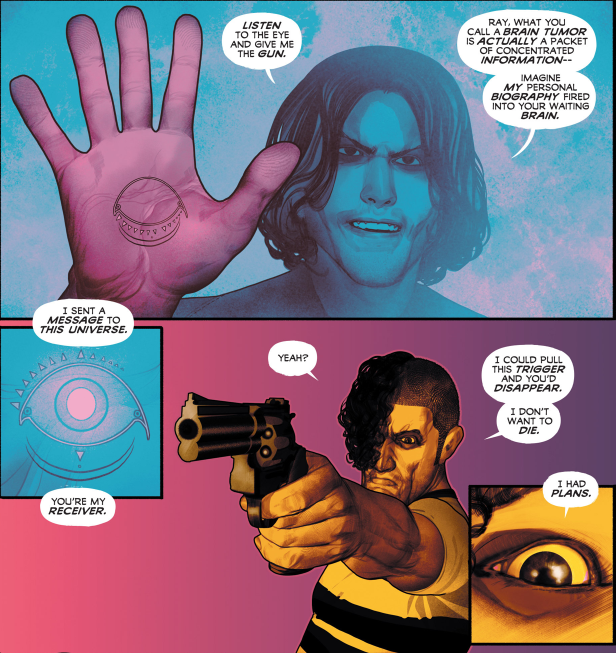
If you’re sick of Grant Morrison’s “writer as God” material, I forgive you. He constantly plays with the notion, even going so far on more than one occasion as to put himself in the comic (e.g., Animal Man). And this year, Morrison produced not one but two “art is life/life is art” books. The first was Multiversity, which appears earlier on this list, and the second was this independent comic with art by his “Batman and Robin” partner Frazier Irving. Annihilator speaks to that theme on a deeper level. In Annihilator, a writer is dying of a brain tumor only to discover that he serves as the link between the metahuman subject of his writing and the actual physical world. Unlike Multiversity, Annihilator is intended to have heft and weight. It’s not a breeze to read—you have to focus and concentrate—which means that as good as it is in loose issue form, the trade will be even better. Last Year: N/A
9. The Amazing Spider-Man (Marvel).
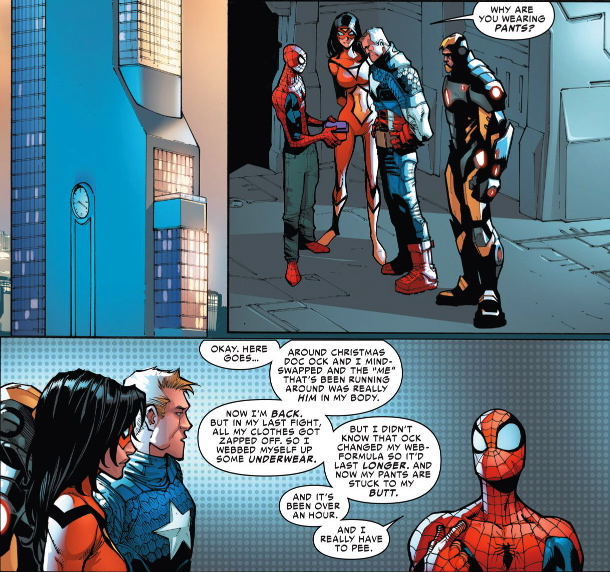
Putting AmSpM on my list is an answer to the fundamental question: “Why did you start reading comics, and why do you still read them decades later when you’re a grown man?” The answer is, first and foremost, that they’re fun. Fun! Yes, there are many on this list that a provocative, or that move the sequential art form forward, but Amazing Spider-Man, from all the way back in issue #1, has always been about telling a cool story that’s relatable on a human level and full of action, bright colors, brighter costumes, and wild imagination. Dan Slott continues to have fresh ideas for this book. Spider-Verse is a little too convoluted for me in many ways, and there are way too many tie-ins, but as a concept? It’s terrific. And its execution in Amazing Spider-Man (disregarding the tie-ins), has been fantastic. I love this book. I’ve read every single issue ever produced, and I don’t intend to stop as long as Marvel continues to publish it. Last Year: Last year, he was “superior,” so there was no “Amazing” on my list, but Superior was #15.
8. Southern Bastards (Image).

The first four issues of this series were a grinding, human tale of personal revenge that could easily be a novel or an FX series or a movie. And when that storyline ended—brutally and abruptly—a new one began that seemed to be an attempt to rehabilitate a bully from the first arc without apologizing for his flaws. This is a complicated book that is really about how damaged people damage people—nobody here is truly righteous, few are true victims, and, truthfully, nobody is safe. So many “realistic” comics are just noir-ish stories of sex and mystery and bullets, but this one isn’t. It’s about bad people doing bad things to less bad people. It’s Clint Eastwood in Grand Torino. It gets inside your head and beats your brain until you’re sore and angry. Last Year: N/A
7. Injustice: Gods Among Us (DC Digital First).
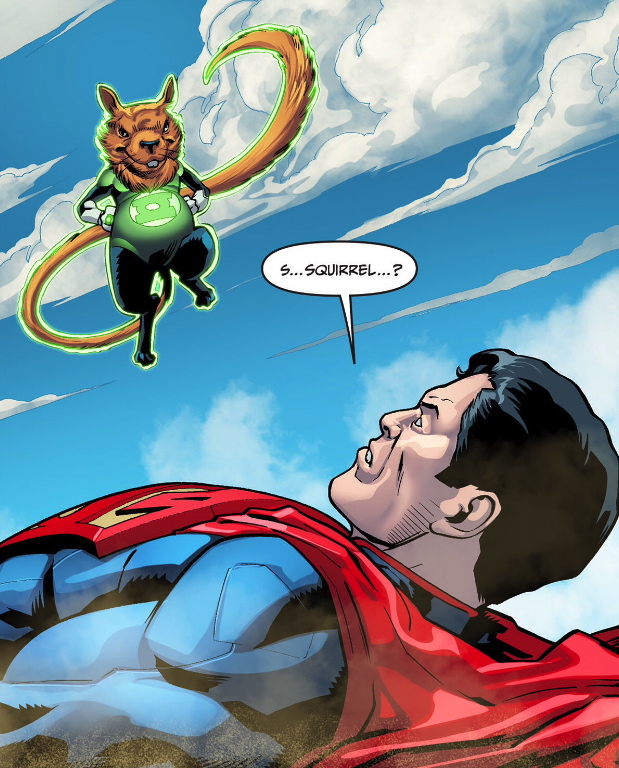
Marvel’s Ultimate Universe editors take note: This is how you tell an “Elseworlds” story. The resemblance to DC canon is clear and evident, and everything these heroes do is completely believable. Every issue matters, characters die, and the drama is constantly ratcheted upwards. This is certainly the most exciting superhero comic of the year. Last Year: #7.

6. This One Summer (First Second).
Jillian and Mariko Tamaki’s ode to the loss of innocence is heartbreaking, funny, warm, beautiful, and just plain amazing. It’s a simple story: A preteen girl and her friend spending the summer at a cottage. All appears idyllic, until the girl’s parents’ marriage starts to unravel, all while she’s experiencing puberty and her first boy crush. If this book doesn’t move you, you simply have no heart.
Oooh! I can’t wait to see what made the top 5!
5. Wytches (Vertigo).
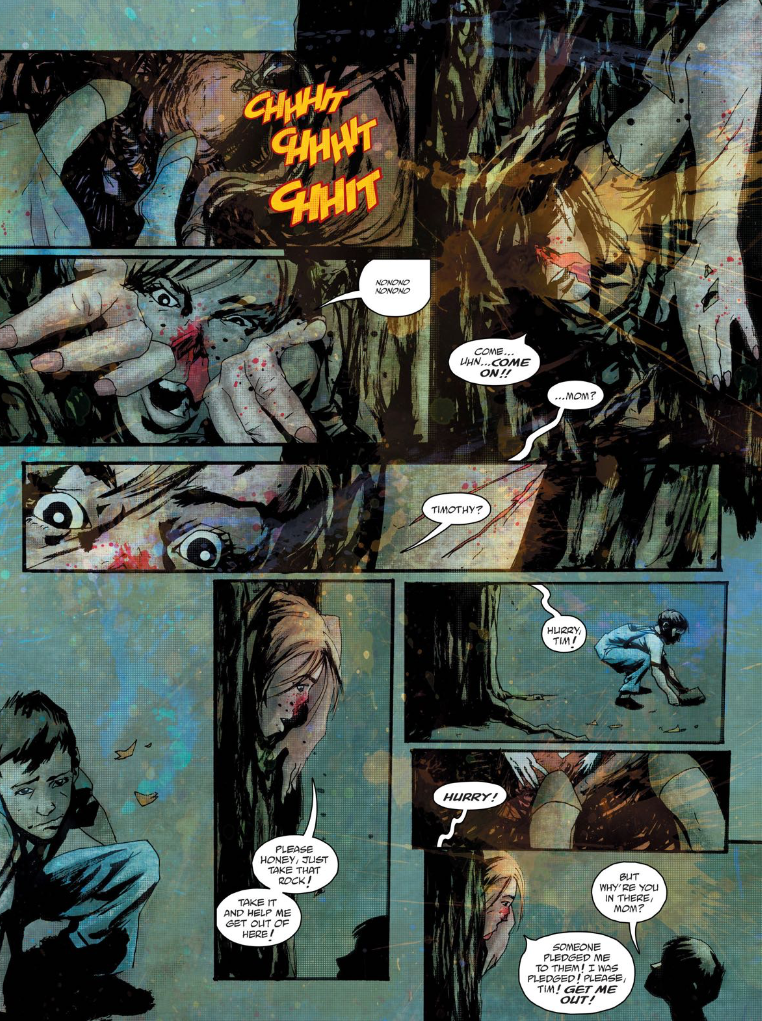
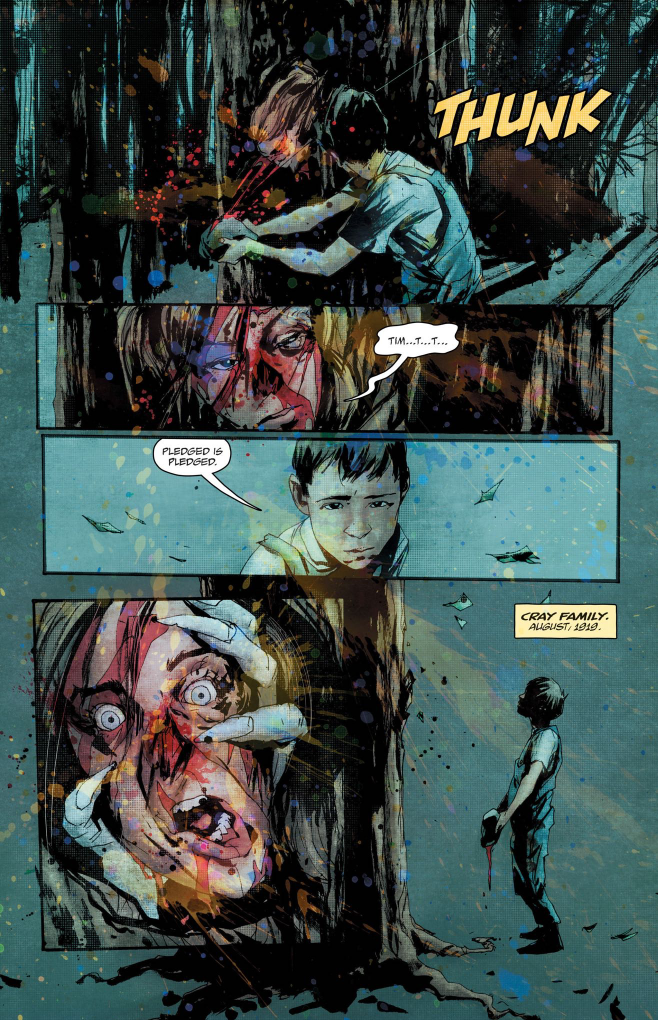
Scott Snyder proved his horror chops on American Vampire. Team him up with Jock, one of the most interesting, and best, artists in the comics medium, and you’ve pretty much got a guaranteed win. The opening sequence of this book (above) may be one of the most chilling I’ve ever seen. And now you’ve seen it, above. Last Year: N/A
4. Moon Knight (Marvel).
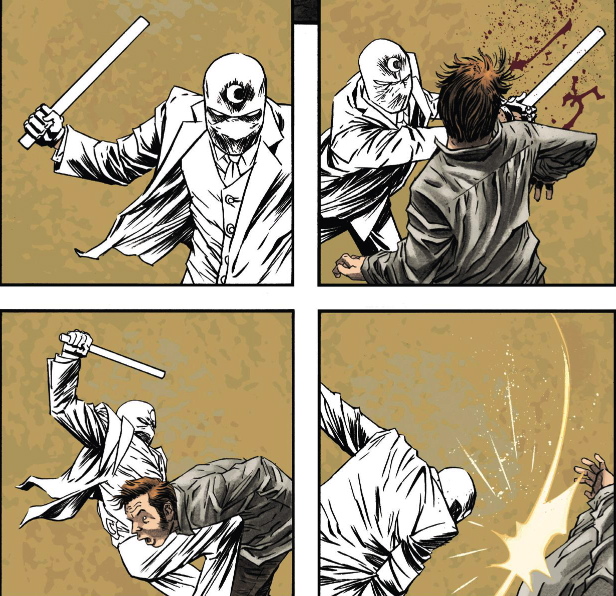
Six issues. That’s all we got of Warren Ellis and Declan Shalvey’s take on Marvel’s schizophrenic, pseudo-mystical hero. But that’s all we needed. In a year where Marvel heavily invested and promoted not one but two martial arts books (Shang Chi and Iron Fist), both of which failed, Moon Knight in one issue showed that comics can be just as kinetic as the movie Raid: Redemption. They also proved that Marvel does Batman way better than DC. Last Year: N/A
3. Alex + Ada (Image).
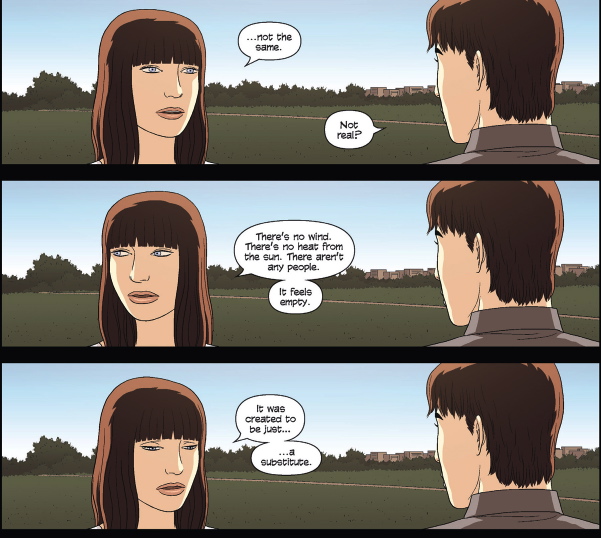
Who would have thought a comic about a sex doll would be so powerful? Jonathan Luna’s work hasn’t changed since The Sword and Girl—his characters all look frozen, cold, and creepy. Which is perfect for this book, since it’s about unfreezing someone who is cold and creepy. The juxtaposition between the main character, who seems soulless and empty, and his sex robot, who craves life more than anything else, is brilliant. Alex is a mama’s boy who seems incapable of love, laughter, or even a genuine smile. Ada is a sex robot who manages to keep her virginity. She recognizes false passion because she was created to display it, and she rejects it the way so many of us reject what we learned from our parents. Sarah Vaughn deserves and Eisner for this book. It’s that well written. Last Year: Honorable Mention.
I bet you can guess #1. But can you guess #2?
2. Ms. Marvel (Marvel).
The first five issues of this comic were a masterpiece—the absolute best origin story since Amazing Fantasy #15 (which is the best origin comic of all time). Writer G. Willow Wilson seemed to understand the need to overcome suspicion that the world’s first Muslim female superhero was nothing more than a gimmick, and did so by emphasizing her humanity, her naiveté, and, yes, her culture. Most superhero origin stories are a variation of the “fish out of water” scenario: A nerd who doesn’t fit in suddenly gets the power craved by everyone who was ever bullied, ignored, or had their parents shot. Wilson, though, extends the narrative: Kamala’s parents are the true fish here—devout Muslims in a culture that doesn’t understand their faith and that, in fact, strongly discourages Kamala from practicing. And as for the art: Adrian Alphona, best known for his work on Runaways, is perfect at drawing kids, capturing the awkwardness of adolescence, and at inserting messages into the background that are often hilarious as well as timely (in particular, the messages on cereal boxes about GMOs). This book is smart, touching, crisp, and wholly innovative—it is not something you usually get from the corporate superhero market, and yet it is right at home in the Marvel family. Last Year: N/A
1. Saga (Image).
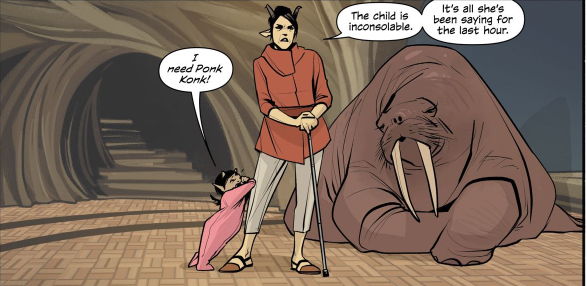
At this point, there’s probably no reason to even give out the top award anymore. This has been the best comic of the year—maybe even the best of all time—ever since issue #1. Last Year: #1
So that’s my list. What did I leave out? What do you disagree with?

How do you continue to sleep on East of West? Or Dream Police? Or Trees? This is what happens when we miss our monthly lunches, you goof.